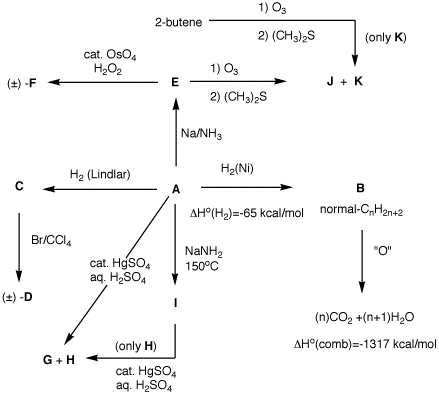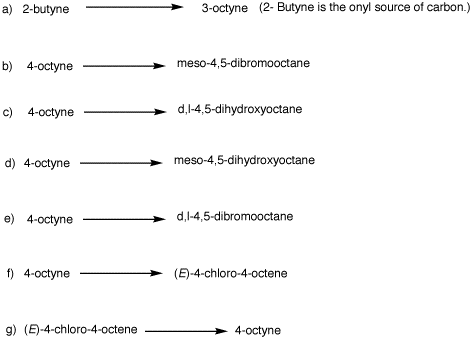|
1. Determine the structures A-K. Explain your reasoning.
|
|
2. Provide reagents for the following reactions. Explain your reasoning.
|
Problem Set 8
Chapter 9
Due: Monday, November 14, 2005
Ozone In 1840, Christian Friedrich Schönbein (1799-1868) discovered ozone (Gr.; odorant), the sharp odor produced by electrical discharges. Seven years later (1847) he observed that ozone oxidizes organic compounds but not to their ultimate products of oxidation, carbon dioxide and water. [Two years prior, he had spilled nitric and sulfuric acid on his Frau's apron in her kitchen. The apron, made of cotton, combusted and thus was discovered gun cotton, nitrocellulose. Schönbein also observed that hydrogen peroxide (Threnard; 1818) is oxidized to oxygen gas in the presense of hemoglobin. ] In the period 1903-1916, Carl Dietrich Harries (1866-1923), an assistant to both Hofmann (of the eponymous elimination and rearrangement) and Fischer (of projection and carbohydrate fame) at Berlin, published some 80 papers on the reactions of ozone with organic compounds. His interest was stimulated by the reaction of ozone with rubber, a process that causes rubber to become hard and brittle. These studies led to the analytical and synthetic uses of ozone. From 1904-1916 he was a professor at Kiel. Disenchanted with academic life, he became Director of Research for Siemens and Halske, the German company co-founded by the electrical pioneer, Werner von Siemens, his father-in-law. Not surprisingly, Siemens went into the business of producing ozone generators. The studies of Rudolf Criegee (1902-1975; Karlsruhe) produced a unified mechanism for the process of ozonolysis.
M. Rubin, Bull. Hist. Chem., 2001, 26, 40.
M. Rubin, Helv. Chem. Acta, 2003, 86, 930.
1. Determine the structures A-K.
Explain your reasoning. 2. Provide reagents for the following
reactions. Explain your reasoning.


|
3. Design a synthesis of muscalure [(Z)-tricos-9-ene], the sex attractant of the common housefly, Musca domestica. As a source of carbon you have available 1-butyne, 1-pentyne and acetylene. You may use 1-pentyne and acetylene only once, i.e, only seven of the carbons may be provided by these two alkynes. all reagents are available. |
|
4. Estimate the heat of formation of 1-,2-,3- and 4-octyne. Equilibration of any one of these isomers with KOH at 200oC produces about as much 2-octyne as 3-octyne both of which individually exceed the amount of 1-octyne. However, the amount of 4-octyne is less than the amount of 2- or 3-octyne. |
|
5. Table I on the right gives the heat of hydrogenation of several cycloalkynes. The authors of the work chose to use the data in Table I rather than Table II to evaluate the strain present in the cycloalkynes. a) Using the information that you learned about strain in cycloalkenes and cycloalkanes (PS6,#2) explain the authors' reasoning. b) Explain the data in Table I. Draw conclusions about the strain in the cycloalkynes. (Why is 4-octyne included when it isn't cyclic?) c) Determine the heat of formation of cyclooctyne. * The authors regard this value as approximate because only 90% of the theoretical amount of H2 was absorbed. |
Table II
|
|
6. The reaction on the right, which was conducted on three different cycloalkynes, was reported in 1985 by Suzanne Abrams and Angela Shaw of the National Research Council of Canada. Rather than use NaNH2 as your text suggests, they used the lithium salt of tetradeutero-1,3-diaminopropane in tetradeutero-1,3-diaminopropane as a solvent at room temperature. a) Name the alkynes used in these experiments. [Note: Not surprisingly, cyclooctyne was found to be unstable to the reaction conditions.] b) The base in this experiment is formed by adding n-butyllithium to the solvent, tetradeutero-1,3-diaminopropane. Use the pKa table to explain why this is a sound way to prepare this base. c) Provide an explanation (mechanism) as to how each methylene group becomes deuterated. [Hint: Such reactions are often called "zipper" reactions. Why?] |
|